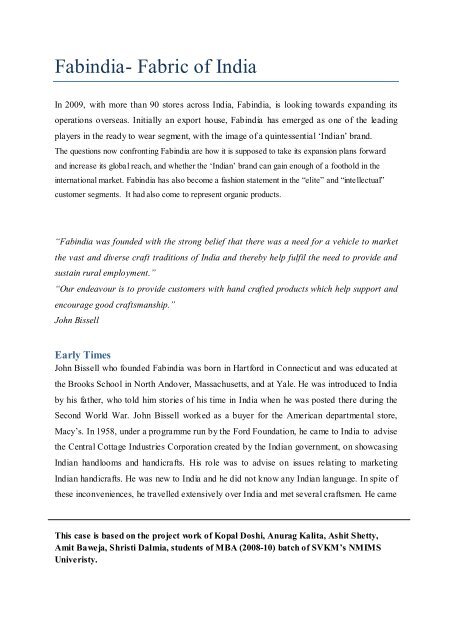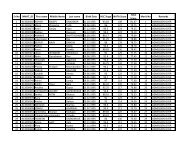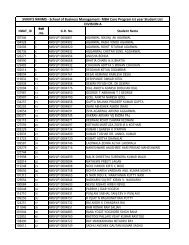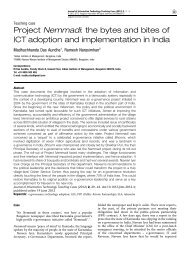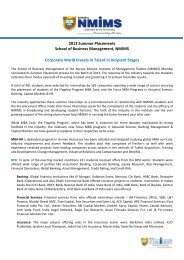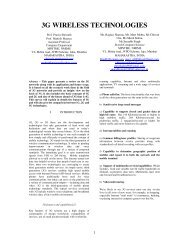Fabindia- Fabric of India - NMIMS
Fabindia- Fabric of India - NMIMS
Fabindia- Fabric of India - NMIMS
Create successful ePaper yourself
Turn your PDF publications into a flip-book with our unique Google optimized e-Paper software.
<strong>Fabindia</strong>- <strong>Fabric</strong> <strong>of</strong> <strong>India</strong><br />
In 2009, with more than 90 stores across <strong>India</strong>, <strong>Fabindia</strong>, is looking towards expanding its<br />
operations overseas. Initially an export house, <strong>Fabindia</strong> has emerged as one <strong>of</strong> the leading<br />
players in the ready to wear segment, with the image <strong>of</strong> a quintessential ‘<strong>India</strong>n’ brand.<br />
The questions now confronting <strong>Fabindia</strong> are how it is supposed to take its expansion plans forward<br />
and increase its global reach, and whether the ‘<strong>India</strong>n’ brand can gain enough <strong>of</strong> a foothold in the<br />
international market. <strong>Fabindia</strong> has also become a fashion statement in the “elite” and “intellectual”<br />
customer segments. It had also come to represent organic products.<br />
“<strong>Fabindia</strong> was founded with the strong belief that there was a need for a vehicle to market<br />
the vast and diverse craft traditions <strong>of</strong> <strong>India</strong> and thereby help fulfil the need to provide and<br />
sustain rural employment.”<br />
“Our endeavour is to provide customers with hand crafted products which help support and<br />
encourage good craftsmanship.”<br />
John Bissell<br />
Early Times<br />
John Bissell who founded <strong>Fabindia</strong> was born in Hartford in Connecticut and was educated at<br />
the Brooks School in North Andover, Massachusetts, and at Yale. He was introduced to <strong>India</strong><br />
by his father, who told him stories <strong>of</strong> his time in <strong>India</strong> when he was posted there during the<br />
Second World War. John Bissell worked as a buyer for the American departmental store,<br />
Macy’s. In 1958, under a programme run by the Ford Foundation, he came to <strong>India</strong> to advise<br />
the Central Cottage Industries Corporation created by the <strong>India</strong>n government, on showcasing<br />
<strong>India</strong>n handlooms and handicrafts. His role was to advise on issues relating to marketing<br />
<strong>India</strong>n handicrafts. He was new to <strong>India</strong> and he did not know any <strong>India</strong>n language. In spite <strong>of</strong><br />
these inconveniences, he travelled extensively over <strong>India</strong> and met several craftsmen. He came<br />
This case is based on the project work <strong>of</strong> Kopal Doshi, Anurag Kalita, Ashit Shetty,<br />
Amit Baweja, Shristi Dalmia, students <strong>of</strong> MBA (2008-10) batch <strong>of</strong> SVKM’s <strong>NMIMS</strong><br />
Univeristy.
across a lot <strong>of</strong> skill, among craftsmen but he also observed that they had no idea about<br />
marketing their products and they were in no position to access distant urban or international<br />
markets. He liked his experiences in <strong>India</strong> and hence kept coming back. What Bissell<br />
discovered was a village-based industry with a pr<strong>of</strong>usion <strong>of</strong> skills hidden from the world.<br />
However, they lacked the skills to market their products and access the large urban and<br />
foreign markets.<br />
Determined to showcase <strong>India</strong>n handloom textiles, and providing equitable employment to<br />
traditional artisans, and sensing an entrepreneurial venture, Bissell established <strong>Fabindia</strong> in<br />
1960. It was also to fuse the best aspects <strong>of</strong> East & West collaboration. Initially, <strong>Fabindia</strong><br />
started as a wholesale export company, concentrating on the export <strong>of</strong> upholstery fabrics,<br />
durries and rugs.<br />
Initially his goal was to export to the US and to other western countries. With that aim in<br />
mind, he incorporated <strong>Fabindia</strong> in 1960. The company operated from Bissell’s residence in<br />
the posh Golf Greens locality in New Delhi. Growth was initially slow for the company and in<br />
1965 the company moved out <strong>of</strong> his house into a proper <strong>of</strong>fice. By then, <strong>Fabindia</strong> had an<br />
annual turnover <strong>of</strong> rupees Rupees 20 lakhs. Most <strong>of</strong> this turnover was accounted for by a<br />
single buyer and a single supplier. A. S. Khera made durries and other home furnishings in his<br />
workshop in Panipat and most <strong>of</strong> the output was purchased by the UK based Habitat, which<br />
was founded by a famous interior designer, Sir Terence Conran.<br />
Retail Foray<br />
Bissell’s Greater Kailash shop was a success. It attracted a distinct category <strong>of</strong> customers.<br />
But in spite <strong>of</strong> such success in its direct retail business, <strong>Fabindia</strong> remained dependent on<br />
exporting and Habitat continued to be their single major buyer. In the early 80’s, <strong>Fabindia</strong><br />
made a significant addition to its product range by adding ready to wear garments too in their<br />
retail <strong>of</strong>ferings. In an interview in 1977, Bissell said, ‘’The greatest thing that happened to our<br />
business was the move in Europe and America a few years back to the natural look - natural<br />
textures, natural fibres - and away from things like polyester and nylon’’. Similarly, like in<br />
Europe and America in <strong>India</strong>, a distinct group was emerging. Some <strong>of</strong> <strong>India</strong>’s new young
politicians, media stars and other celebrities patronized <strong>Fabindia</strong> and were able to provide<br />
<strong>Fabindia</strong> with nationwide exposure for its products. In spite <strong>of</strong> all that, its domestic retail<br />
business grew slowly. It continued to focus on export business.<br />
However as time passed <strong>Fabindia</strong>'s marketing shifted from exports, to the local <strong>India</strong>n retail<br />
market. This was especially so from 1990s.<br />
In 1999, on John Bissell’s death, his son William aged 32,formally took over as the<br />
Managing Director <strong>of</strong> <strong>Fabindia</strong>. The Company’s domestic expansion had been spectacular<br />
after William took over. By 2001, <strong>Fabindia</strong> had six stores concentrated in the metro cities. By<br />
the end <strong>of</strong> 2004, these had increased to 20, and the company was seriously considering<br />
expanding its stores into the tier-II and tier-III, cities as well as overseas. By the end <strong>of</strong> 2007<br />
<strong>Fabindia</strong> had 75 retail stores across <strong>India</strong> and in addition, stores in Dubai, Rome and<br />
Guangzhou in China.<br />
<strong>Fabindia</strong> across <strong>India</strong><br />
What started as an export house has today become a successful retail business presenting<br />
<strong>India</strong>n textiles in a variety <strong>of</strong> natural fibres, and home products including furniture, lights and<br />
lamps, stationery, home accessories, pottery and cutlery. In 2004, food products range was<br />
launched and in 2006, <strong>Fabindia</strong> Sana, their authentic body care products range, was launched.<br />
Recently, it has also ventured into the jewellery segment. However, the major chunk <strong>of</strong><br />
<strong>Fabindia</strong>’s product range is textile-based.<br />
The company has continued its focus mainly on the artisans and sources its products from<br />
over 15,000 craftsmen across <strong>India</strong>. With a strong foundation, the company has been<br />
successful in increasing its presence all over <strong>India</strong>.<br />
Channels <strong>of</strong> business<br />
It has created a visibility in the international market either through its own stores or through<br />
other retailers and boutiques and also through institutional sales. The main advantage<br />
<strong>Fabindia</strong> has enjoyed is that its products have a distinctive and quintessential style and it can<br />
easily be identified by potential customers.
Retail<br />
The retail channel is already developed within <strong>India</strong> with almost 100 stores in Tier 1 and Tier<br />
II cities. As <strong>of</strong> today, internationally <strong>Fabindia</strong> owns stores in Rome (Italy), Guangzhou<br />
(China), Dubai (UAE), Manama (Bahrain) and Doha (Qatar).<br />
The product range consists <strong>of</strong> garments for men, women, children and infants; garment<br />
accessories; home furnishings – bed, bath, table and kitchen linen, upholstery fabric, curtains,<br />
floor coverings and a range <strong>of</strong> non textile products like furniture, lights, lamps and stationery.<br />
In addition to handcrafted clothing and home furnishings, <strong>Fabindia</strong>’s product line includes<br />
organic foods and body care products.<br />
Wholesale exports<br />
As <strong>of</strong> today, <strong>Fabindia</strong> exports to more than 34 countries. The clients are wholesalers as well<br />
as secondary retailers. Products exported include home linens as well as garments. Exports<br />
are done as per the Terms and Conditions agreed by <strong>Fabindia</strong> and the customer.<br />
The export being a very lucrative market, <strong>Fabindia</strong> develops a special collection for exports<br />
markets twice every year. The special collections are showcased at the <strong>India</strong>n Handicrafts and<br />
Gifts Fair, New Delhi in Spring and Autumn. This collection draws on different techniques to<br />
present a range <strong>of</strong> home furnishings comprising bed and table linen, with a focus on textures<br />
– both visual and tactile. As different wholesalers and retailers flock to these fairs to address<br />
their sourcing needs, <strong>Fabindia</strong> is able to reach out to potential clients.<br />
Institutional Sales<br />
<strong>Fabindia</strong> envisages to service high business institutional segment especially the heritage<br />
hotels and multinational corporate houses. It provides customization and interior designing<br />
consulting for clients like heritage hotels, resorts and corporate houses.<br />
Mechandise Mix:<br />
During the early days, merchandising was not a planned activity. Whenever Bissell saw<br />
something <strong>of</strong> interest, he procured it for display at the store. Sometimes he would also invite<br />
the craftsmen , to display the products and assist in the sale. This orientation <strong>of</strong> customer<br />
relationship later became a part <strong>of</strong> the company culture.<br />
The expansion in merchandize mix is mainly done through customer feedback especially that<br />
<strong>of</strong> its loyal customers. <strong>Fabindia</strong> believes: “ A delighted Customer is our Best Brand<br />
Ambassador”
<strong>Fabindia</strong> does not follow any customer acquisition strategy. It instead focuses on customer<br />
retention. <strong>Fabindia</strong> creates its market through its existing customers which is quite evident<br />
from the fact that about 85% <strong>of</strong> its customers are repeat customers. The Unique Selling<br />
Proposition <strong>of</strong> <strong>Fabindia</strong> is the quality <strong>of</strong> the fabric and the traditional style, which is always in<br />
vogue. It has designed the stores’ decor and ambience keeping this in mind. It constantly<br />
attempts to improve the quality <strong>of</strong> the products in order to retain its customers.<br />
The company concentrates on customer feedback by maintaining a visitors’ register to record<br />
customer views. The store managers prepare a report on buying pattern among consumers<br />
which is periodically reviewed by the Product Selection Committee at <strong>Fabindia</strong> . Recently,<br />
the CRM s<strong>of</strong>tware has been implemented in a select few stores which aims to help in<br />
maintaining a centralized database. This will help <strong>Fabindia</strong> in retaining customers by building<br />
lasting relationships and improving loyalty. The implementation, however, is still in its<br />
nascent stage, but is soon expected to be spread across all the stores in the country. <strong>Fabindia</strong><br />
also has the Mystery Shopper Program to gauge the customer satisfaction level. Mystery<br />
shoppers posing as normal customers perform specific tasks such as purchasing a product,<br />
asking questions, registering complaints or behaving in a certain way and then provide<br />
detailed reports or feedback on their shopping experiences to the management. It serves as an<br />
effective tool to improve the customer experience.<br />
Moreover, the brand managers at <strong>Fabindia</strong> rely upon a concept <strong>of</strong> intuition. If a new line <strong>of</strong><br />
traditional kurtis is launched, the jewellery which suits the attire also gets launched. It<br />
automatically gets sold without any promotion. Before launching any new product, be it<br />
traditional, western, organics, jewellery or furniture, <strong>Fabindia</strong> looks into the value which a<br />
customer may feel by having the product as a part <strong>of</strong> his/her life. Some customers are so<br />
inclined to <strong>Fabindia</strong> that they just don’t believe in going elsewhere else, and don’t even tell<br />
other people that they have purchased the particular item from <strong>Fabindia</strong>.This helps them<br />
create an image <strong>of</strong> exclusiveness . Hence, uniqueness, innovation and intuition are the most<br />
important aspects <strong>of</strong> <strong>of</strong> <strong>Fabindia</strong>’s product planning.<br />
Store layout and location:<br />
The store layout in <strong>Fabindia</strong> depends upon the type <strong>of</strong> store. <strong>Fabindia</strong> works on various types<br />
<strong>of</strong> stores which include concept stores as well as full fledged store. In a posh locality in a<br />
metropolitan city, <strong>Fabindia</strong> works as a full fledged store which has almost all the product<br />
lines. On the other hand, in a concept store, the place specific products are retailed. Market
potential determines store location for <strong>Fabindia</strong>, which is fast expanding in Tier II cities like<br />
Bhopal where still mall culture is non existent.<br />
The layout usually keeps clothes section at the back <strong>of</strong> the store and the entrance area is<br />
utilized for home products. The exclusive jewellery counter is also kept in the fronts.<br />
Why <strong>Fabindia</strong>?<br />
<strong>Fabindia</strong> since its inception has concentrated on cultivating an image <strong>of</strong> ‘<strong>India</strong>nness’. Relying<br />
on its word <strong>of</strong> mouth publicity, <strong>Fabindia</strong> has been highly successful in creating a pool <strong>of</strong><br />
repeat customers, who come again and again for the unique <strong>Fabindia</strong> experience.<br />
The core values <strong>of</strong> <strong>Fabindia</strong> have always been to provide its customers with quality products<br />
which reflect the unique <strong>India</strong>n culture and tradition. Since most <strong>of</strong> <strong>Fabindia</strong>’s customers are<br />
repeat customers, the motivating factor for the customer remains the quality and consistency<br />
<strong>of</strong> product and the service provided by <strong>Fabindia</strong>.<br />
The major problems for <strong>Fabindia</strong> occur in the maintaining the consistency <strong>of</strong> the products.<br />
Since the supply and the manufacturing happens on a small scale over a large geographical, it<br />
becomes difficult for the firm to maintain the same level <strong>of</strong> quality. <strong>Fabindia</strong> makes sure that<br />
a minimum level <strong>of</strong> quality is maintained, but it also has strong relationships with all its<br />
suppliers. It makes sure that a supplier does not suffer due to marginal quality lapses. The<br />
<strong>Fabindia</strong> customers also understand this and are largely tolerant <strong>of</strong> the discrepancies in<br />
garment in terms <strong>of</strong> size & prints etc. In fact, over 77% <strong>of</strong> the customers buy <strong>Fabindia</strong>,<br />
because <strong>of</strong> the ‘<strong>Fabindia</strong>’ brand and its contribution to improving the life <strong>of</strong> rural artisans.<br />
<strong>Fabindia</strong> has in store posters which educate customers about the dyes used in the products,<br />
and also the possible problems which could be faced in washing and using them. Thus,<br />
<strong>Fabindia</strong> has succeeded in making the inherent inconsistency <strong>of</strong> the product into an appeal<br />
factor by positioning each garment as ‘unique’.<br />
Also, even though the products sometimes have problems due to the fading <strong>of</strong> colours, or<br />
shrinkage, the service personnel make sure that the customers are not inconvenienced on<br />
account <strong>of</strong> such problems. The general response is to exchange the garment for another,<br />
which makes sure that the customer goes back happy, and remains a loyal customer.<br />
In case <strong>of</strong> organic products, it is still a nascent market. Itts appeal is mostly to people who are<br />
already aware <strong>of</strong> the product <strong>of</strong>fering and have been using similar products. The major
problem there is erratic delivery and product availability, which does lead to customer<br />
dissatisfaction. But this is a very small part <strong>of</strong> the clientele. Over 83% <strong>of</strong> <strong>Fabindia</strong>’ s<br />
customers go abck satisfied, with 58% being highly satisfied with the brand and its <strong>of</strong>ferings.<br />
<strong>Fabindia</strong> has been expanding its product range to include jewellery, home furnishings, Body<br />
care products, etc. This has mostly been done as an extension <strong>of</strong> the Garment brand. For<br />
example, the men’s garment range was started because the founder, John Bissell, needed<br />
shirts. Therefore, for quite some time, the <strong>Fabindia</strong> men’s garment line was restricted to shirts<br />
and that too in only one size, because it was John’s shirt size!<br />
Although <strong>Fabindia</strong> appeals to the <strong>India</strong>n customer’s need to remain rooted with the tradition<br />
and culture, it has made sure that it changes with the times. It had inculcated a large number<br />
<strong>of</strong> western fashions and garments into its range. This is done keeping in mind the customer<br />
feedback received and the inputs given by the store managers. <strong>Fabindia</strong> relies on its managers<br />
to identify client needs and trim the store <strong>of</strong>ferings accordingly.<br />
Competition:<br />
Competition Faced by <strong>Fabindia</strong> is from both the organised and unorganised retail sector. The<br />
unorganised sector has the local tailors who provide customised garments to the customers<br />
at reasonable prices and the local NGOs selling wares. However, the scale <strong>of</strong> operations does<br />
not pose a major threat to <strong>Fabindia</strong>.<br />
One such competitor is the Delhi Haat, an upgraded traditional weekly market, located in the<br />
hub <strong>of</strong> south Delhi. The place has been developed by the Tourist Department <strong>of</strong> Delhi to<br />
enhance the craftsmanship <strong>of</strong> our country. It is an amalgamation <strong>of</strong> craft, food and cultural<br />
activities. Unlike the village haat, the Delhi haat is a permanent haat that <strong>of</strong>fers a<br />
kaleidoscopic view <strong>of</strong> the richness and diversity <strong>of</strong> the <strong>India</strong>n handicrafts and artefacts.<br />
Spread over a spacious six acre area, imaginative landscaping, creative planning, and the<br />
traditional village architectural style provide for a major tourist attraction. One is very happy<br />
to get goods at a very nominal price here.<br />
Another such regional competitor is the market outside the law garden in Ahmedabad. The<br />
law garden is a famous place for buying handicrafts and Gujarati outfits from local hawkers.<br />
This garden provides one with various recreational options like music, theatre, rides for kids<br />
and a great variety <strong>of</strong> Gujarati food.<br />
The common thread that links both the Delhi Haat and the Law Garden is the experience they<br />
create for the customer by combining crafts, food and cultural activities. Such an experience
is lacking in case <strong>of</strong> <strong>Fabindia</strong>. A tourist would be lured by the overall ambience he gets in the<br />
former case.<br />
However, a far greater threat is posed by the organised sector especially Government owned<br />
Khadi Gram Udyog outlets and Cottage Industries Emporiums across the country. The<br />
product mix <strong>of</strong>fered by both is similar to <strong>Fabindia</strong>. Also, they have the backing <strong>of</strong> the<br />
governments. However, the quality <strong>of</strong> products and service provided by <strong>Fabindia</strong> is perceived<br />
to be higher than that <strong>of</strong> the government run outlets.<br />
<strong>Fabindia</strong>’s main competitors are the ethnic wear retailers like Khadder, W and Good Things,<br />
who are also expanding at a rapid pace. W, for example, has well over 30 exclusive stores<br />
now, in addition to being available at some multi-brand outlets.. There is also severe<br />
competition from the ethnic wear labels <strong>of</strong> modern <strong>India</strong>n retail chains, such as Shoppers<br />
Stop and Pantaloons. Stand alone stores like Shristi and Biba in Bangalore, Prapti in Kolkata<br />
and Sadka and Shoma in Delhi have been doing well for a while and could pose a challenge<br />
by expanding. New competition is expected from overseas retailers also. The government<br />
has already permitted single brand retailers to set up shop and others like Carrefour, Walmart<br />
and Metro have devised ways to get into the <strong>India</strong>n market. Powerful <strong>India</strong>n business houses<br />
like Tata, Reliance and Birla are expanding their retail businesses.<br />
The organised retail sector also includes outlets by corporate houses like Lifestyle and<br />
Westside which cater to the same demographic pr<strong>of</strong>ile. However, the products served are<br />
more contemporary in nature and does not aim at the same target audience. Stores like<br />
Anokhi have the same target audience, but do not have the reach <strong>of</strong> <strong>Fabindia</strong>.<br />
International Presence<br />
<strong>Fabindia</strong> has gradually attained a strong foothold in <strong>India</strong>. It has become the niche player <strong>of</strong><br />
choice for the urban and semi-urban masses when it comes to buying something with “<strong>India</strong>n<br />
flavour” added. The constant product innovations and agility in identifying associated<br />
product lines has been the key. Be it garments with distinctive folk patterns to furniture with<br />
carvings and designs reflective <strong>of</strong> rich <strong>India</strong>n heritage, the products have an intrinsic appeal<br />
to customers.
As <strong>of</strong> January 2009, they have 97 stores across the length <strong>of</strong> the country. They have also<br />
opened international stores in Italy, UAE, Qatar and China. Their network is spread across 34<br />
countries worldwide and 511 destinations in <strong>India</strong>. 1<br />
Market<br />
From a turnover <strong>of</strong> 36 crore rupees in 2000-01, <strong>Fabindia</strong> has grown to having a turnover <strong>of</strong><br />
Rs.130 crore in 2005-06. It registered a CAGR <strong>of</strong> about 38% in the period 2002-06. Such<br />
phenomenal growth has not come at the cost <strong>of</strong> pr<strong>of</strong>its. The pr<strong>of</strong>itability has been maintained<br />
at a rate <strong>of</strong> 6% for the entire period (See Figure- 2). For <strong>Fabindia</strong> William Bissell has set a<br />
very ambitious target <strong>of</strong> reaching 250 stores and a turnover <strong>of</strong> Rs.1000 crore by 2011. The<br />
growth is expected to come from new stores as well as increase in sales from existing stores.<br />
That increase will be achieved by increased emphasis on premium products. Also, <strong>Fabindia</strong><br />
has attempted to decrease its dependence on fabric based businesses by increasing its other<br />
product lines. Currently organic foods, body care products and handicrafts form a significant<br />
part <strong>of</strong> its total sales. Growth in locations was expected to come from expansion in overseas<br />
markets as well as a greater penetration <strong>of</strong> the markets in smaller towns in <strong>India</strong>. As<br />
mentioned earlier, <strong>Fabindia</strong> planned to expand significantly in tier-II and tier-III cities in<br />
<strong>India</strong>. <strong>India</strong> has a flourishing retail business but most <strong>of</strong> it is in the unorganized sector. There<br />
are estimated to be over 120 lakh stores in the country. Of this, organized retail is only 3%<br />
but is growing at the rate <strong>of</strong> 18%. This organized retail sector is vying for a share <strong>of</strong> the<br />
spending <strong>of</strong> <strong>India</strong>’s rapidly growing middle class whose purchasing power is estimated to be<br />
around Rs. 10 lakh crore. An estimate made by a pr<strong>of</strong>essional demand forecaster shows that<br />
out <strong>of</strong> the total retail business potential, the <strong>India</strong>n market for ethnic wear is likely to be a<br />
about Rs. 9000 crore.For geographies outside <strong>of</strong> <strong>India</strong>, there is a strong mysticism about<br />
<strong>India</strong>n culture and hence the products reflective <strong>of</strong> <strong>India</strong>n folk art hold great potential in those<br />
markets.<br />
Given the over 8% growth in the <strong>India</strong>n market and an upwardly mobile <strong>India</strong> consumer, it<br />
was quite clear that product and services enable a customer to make a statement, are going to<br />
grow in volume and value. The question before <strong>Fabindia</strong> Management is that <strong>of</strong> making<br />
<strong>Fabindia</strong> product exclusive or mass product. If he decided to make it exclusive, then it will<br />
have to look at issues <strong>of</strong> product design, store layout and even the store ambiance.
Increasingly, its competitors were using ethnic themes for their store layouts as also for<br />
designing garments.<br />
EXHIBITS
Store Layout: Upholstery<br />
Competitors <strong>of</strong> <strong>Fabindia</strong>
UNORGANIZED SECTOR<br />
STRENGTHS WEAKNESSES<br />
Tailoring Outlets 1. Reaching out to customer<br />
NGOs Promoting<br />
Handicrafts<br />
ORGANIZED SECTOR<br />
RETAILING HOUSES :<br />
Garments Based (Shoppers<br />
Stop, Westside, Reliance<br />
Trends, Globus)<br />
Government Handloom<br />
Initiatives<br />
(Khadi Gramodyog, Cottage<br />
Industries Emporium, State<br />
Government departments)<br />
with larger dispersion.<br />
2. Ensures convenience <strong>of</strong><br />
demanding service.<br />
1. Strong community based<br />
operations.<br />
2. Complementary products<br />
manufactured with other<br />
firms.<br />
1. National presence <strong>of</strong> outlets.<br />
2. Retailing expertise and<br />
competitive pricing.<br />
3. Agility for quick product<br />
development cycles.<br />
1. Strong legacy attached to<br />
products.<br />
2. Subsidized manufacturing<br />
and costs.<br />
Designer Boutiques 1. Scope <strong>of</strong> product<br />
customization.<br />
1. Very fragmented business<br />
approach.<br />
1. Lack <strong>of</strong> retailing expertise<br />
and inability to minimize<br />
costs.<br />
2. Products are mostly produced<br />
for souvenirs or artifacts <strong>of</strong><br />
collector’s interest.<br />
1. Diversity <strong>of</strong> product is very<br />
less.<br />
2. Retailing brands and in-house<br />
labels have a considerable<br />
share <strong>of</strong> product mix. The<br />
trends are designed as per<br />
recent garments and<br />
accessories trends.<br />
1. Business is heavily<br />
influenced by bureaucratic<br />
approach <strong>of</strong> employees.<br />
2. No significant product<br />
evolution.<br />
1. No uniformity in price across<br />
products.
Organic Foods (Reliance,<br />
Godrej Agrovet, ITC Foods,<br />
Organic <strong>India</strong>)<br />
2. Highest level <strong>of</strong> customer<br />
intimacy.<br />
1. Well established business<br />
houses with high brand<br />
equity.<br />
2. Established and<br />
technologically equipped<br />
supply chains.<br />
FABINDIA MODELLED GARMENT HOUSES<br />
Anokhi 1. Differentiable products.<br />
2. Established brand and<br />
market.<br />
Bombay (Swadeshi) Stores 1. Servicing high value<br />
customers.<br />
2. Limited models <strong>of</strong> SKUs<br />
manufactured.<br />
1. Pr<strong>of</strong>itability concerns as<br />
organic market is still at<br />
nascent state.<br />
1. Minimal product lines.<br />
2. Handicrafts from western<br />
regions<br />
1. Only located in Mumbai<br />
2. Priced at a much higher<br />
prices than average <strong>Fabindia</strong><br />
prices.
SWOT Analysis<br />
STRENGTHS<br />
THREATS<br />
Differentiable products<br />
Brand recognition and loyalty<br />
Diverse product mix<br />
Partnering with suppliers<br />
In-house manufacturing<br />
Price Trends Setter<br />
Different categories <strong>of</strong> stores<br />
Customer Loyalty<br />
Substitute producing<br />
competitors<br />
Not in touch with Fashion<br />
Trends<br />
No specific promotions<br />
strategy<br />
Limited channels <strong>of</strong> business<br />
Sourcing strategy skewed<br />
towards suppliers<br />
Inconsistent quality <strong>of</strong><br />
products<br />
Inconsistent service in stores<br />
In store merchandising &<br />
navigation<br />
Promoting e-business channel<br />
Organic foods market<br />
Customer acquisition<br />
strategies<br />
WEAKNESSES<br />
OPPORTUNITIES


